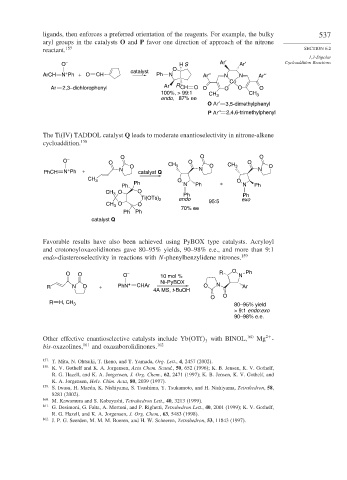Page 563 - Advanced Organic Chemistry Part B - Reactions & Synthesis
P. 563
ligands, then enforces a preferred orientation of the reagents. For example, the bulky 537
aryl groups in the catalysts O and P favor one direction of approach of the nitrone
reactant. 157 SECTION 6.2
1,3-Dipolar
O – H S Ar′ Ar′ Cycloaddition Reactions
O
catalyst
+
ArCH N Ph + O CH Ph N Ar′′ N N Ar′′
Co
Ar 2,3–dichlorophenyl Ar R CH O O O O O
100%, > 99:1 CH 3 CH 3
endo, 87% ee
O Ar′ 3,5-dimethylphenyl
P Ar′′ 2,4,6-trimethylphenyl
The Ti(IV) TADDOL catalyst Q leads to moderate enantioselectivity in nitrone-alkene
cycloaddition. 158
O O O
O – O O O
O CH 3 N O CH 3 O
+
PhCH N Ph + N catalyst Q N
CH 3 O O
Ph Ph N Ph + N Ph
O O
CH 3 Ph Ph
Ti(OTs) 2 endo exo
CH 3 O O 95:5
Ph Ph 70% ee
catalyst Q
Favorable results have also been achieved using PyBOX type catalysts. Acryloyl
and crotonoyloxazolidinones gave 80–95% yields, 90–98% e.e., and more than 9:1
endo-diastereoselectivity in reactions with N-phenylbenzylidene nitrones. 159
O O O – 10 mol % R O N Ph
Ni-PyBOX
+
R N O + PhN CHAr O N Ar
4A MS, t-BuOH
O O
R H, CH 3 80–95% yield
> 9:1 endo:exo
90–98% e.e.
Other effective enantioselective catalysts include Yb OTf with BINOL, 160 Mg -
2+
3
bis-oxazolines, 161 and oxazaborolidinones. 162
157 T. Mita, N. Ohtsuki, T. Ikeno, and T. Yamada, Org. Lett., 4, 2457 (2002).
158 K. V. Gothelf and K. A. Jorgensen, Acta Chem. Scand., 50, 652 (1996); K. B. Jensen, K. V. Gothelf,
R. G. Hazell, and K. A. Jorgensen, J. Org. Chem., 62, 2471 (1997); K. B. Jensen, K. V. Gothelf, and
K. A. Jorgensen, Helv. Chim. Acta, 80, 2039 (1997).
159
S. Iwasa, H. Maeda, K. Nishiyama, S. Tsushima, Y. Tsukamoto, and H. Nishiyama, Tetrahedron, 58,
8281 (2002).
160 M. Kawamura and S. Kobayashi, Tetrahedron Lett., 40, 3213 (1999).
161 G. Desimoni, G. Faita, A. Mortoni, and P. Righetti, Tetrahedron Lett., 40, 2001 (1999); K. V. Gothelf,
R. G. Hazell, and K. A. Jorgensen, J. Org. Chem., 63, 5483 (1998).
162
J. P. G. Seerden, M. M. M. Boeren, and H. W. Scheeren, Tetrahedron, 53, 11843 (1997).

